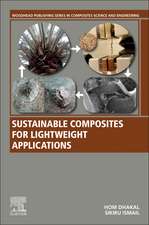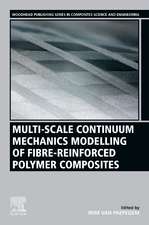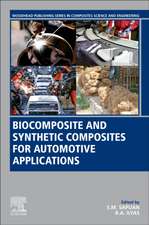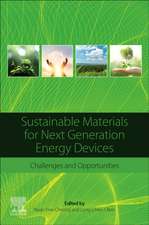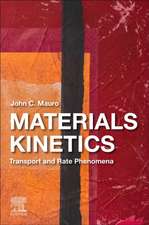Representative Volume Elements and Unit Cells: Concepts, Theory, Applications and Implementation: Woodhead Publishing Series in Composites Science and Engineering
Autor Shuguang Li, Elena Sitnikovaen Limba Engleză Paperback – 19 noi 2019
- The companion site for the book can be found at https://www.elsevier.com/books-and-journals/book-companion/9780081026380
- The theories presented in this book will give users more confidence when applying RVE and UC models to analyse materials of complex architectures with accuracy and efficiency
- Systematic explanations of RVE and UC theories have been included, as well as their applications in composites
- It illustrates in detail how to set up UC models and provides an open source code to implement via Abaqus
Din seria Woodhead Publishing Series in Composites Science and Engineering
- 29%
 Preț: 1153.66 lei
Preț: 1153.66 lei - 29%
 Preț: 1477.86 lei
Preț: 1477.86 lei - 24%
 Preț: 1160.48 lei
Preț: 1160.48 lei - 39%
 Preț: 1153.30 lei
Preț: 1153.30 lei - 24%
 Preț: 1451.12 lei
Preț: 1451.12 lei - 9%
 Preț: 1019.80 lei
Preț: 1019.80 lei - 29%
 Preț: 1129.94 lei
Preț: 1129.94 lei - 9%
 Preț: 1049.32 lei
Preț: 1049.32 lei - 29%
 Preț: 1067.77 lei
Preț: 1067.77 lei - 9%
 Preț: 1069.37 lei
Preț: 1069.37 lei - 29%
 Preț: 1326.23 lei
Preț: 1326.23 lei - 29%
 Preț: 1243.53 lei
Preț: 1243.53 lei - 29%
 Preț: 1213.41 lei
Preț: 1213.41 lei - 39%
 Preț: 1155.04 lei
Preț: 1155.04 lei - 9%
 Preț: 1006.50 lei
Preț: 1006.50 lei - 29%
 Preț: 1067.31 lei
Preț: 1067.31 lei - 9%
 Preț: 1140.31 lei
Preț: 1140.31 lei - 9%
 Preț: 1069.99 lei
Preț: 1069.99 lei - 24%
 Preț: 1130.20 lei
Preț: 1130.20 lei - 9%
 Preț: 904.59 lei
Preț: 904.59 lei - 23%
 Preț: 999.53 lei
Preț: 999.53 lei - 9%
 Preț: 1542.98 lei
Preț: 1542.98 lei - 23%
 Preț: 992.64 lei
Preț: 992.64 lei - 9%
 Preț: 1210.03 lei
Preț: 1210.03 lei - 9%
 Preț: 1328.05 lei
Preț: 1328.05 lei - 24%
 Preț: 1563.73 lei
Preț: 1563.73 lei - 24%
 Preț: 1159.26 lei
Preț: 1159.26 lei - 24%
 Preț: 1559.63 lei
Preț: 1559.63 lei - 9%
 Preț: 1212.62 lei
Preț: 1212.62 lei - 29%
 Preț: 1158.40 lei
Preț: 1158.40 lei - 28%
 Preț: 1075.60 lei
Preț: 1075.60 lei - 29%
 Preț: 1158.75 lei
Preț: 1158.75 lei - 29%
 Preț: 925.09 lei
Preț: 925.09 lei - 29%
 Preț: 1417.65 lei
Preț: 1417.65 lei - 9%
 Preț: 989.97 lei
Preț: 989.97 lei - 29%
 Preț: 1479.85 lei
Preț: 1479.85 lei - 9%
 Preț: 1335.20 lei
Preț: 1335.20 lei - 29%
 Preț: 1189.81 lei
Preț: 1189.81 lei - 9%
 Preț: 1069.82 lei
Preț: 1069.82 lei - 33%
 Preț: 946.33 lei
Preț: 946.33 lei - 24%
 Preț: 955.72 lei
Preț: 955.72 lei - 29%
 Preț: 1186.95 lei
Preț: 1186.95 lei - 29%
 Preț: 1393.64 lei
Preț: 1393.64 lei - 9%
 Preț: 1011.50 lei
Preț: 1011.50 lei - 9%
 Preț: 1071.27 lei
Preț: 1071.27 lei - 24%
 Preț: 1234.77 lei
Preț: 1234.77 lei - 9%
 Preț: 1208.48 lei
Preț: 1208.48 lei - 9%
 Preț: 1308.84 lei
Preț: 1308.84 lei - 29%
 Preț: 1311.49 lei
Preț: 1311.49 lei
Preț: 1130.30 lei
Preț vechi: 1482.54 lei
-24% Nou
Puncte Express: 1695
Preț estimativ în valută:
216.27€ • 225.83$ • 178.60£
216.27€ • 225.83$ • 178.60£
Carte tipărită la comandă
Livrare economică 09-23 aprilie
Preluare comenzi: 021 569.72.76
Specificații
ISBN-13: 9780081026380
ISBN-10: 0081026382
Pagini: 482
Dimensiuni: 152 x 229 x 29 mm
Greutate: 0.64 kg
Editura: ELSEVIER SCIENCE
Seria Woodhead Publishing Series in Composites Science and Engineering
ISBN-10: 0081026382
Pagini: 482
Dimensiuni: 152 x 229 x 29 mm
Greutate: 0.64 kg
Editura: ELSEVIER SCIENCE
Seria Woodhead Publishing Series in Composites Science and Engineering
Cuprins
Preface
Part One: Basics
1. Introduction d background, objectives and basic concepts
2. Symmetry, symmetry transformations and symmetry conditions
3. Material categorisation and material characterisation
4. Representative volume elements and unit cells
5. Common erroneous treatments and their conceptual sources of errors
Part Two: Consistent formulation of unit cells and representative volume elements
6. Formulation of unit cells
7. Periodic traction boundary conditions and the key degrees of freedom for unit cells
8. Further symmetries within a UC
9. RVE for media with randomly distributed inclusions
10. The diffusion problem
11. Boundaries of applicability of representative volume elements and unit cells
Part Three: Further developments
12. Applications to textile composites
13. Application of unit cells to problems of finite deformation
14. Automated implementation: UnitCells© composites characterisation code
Index
Part One: Basics
1. Introduction d background, objectives and basic concepts
2. Symmetry, symmetry transformations and symmetry conditions
3. Material categorisation and material characterisation
4. Representative volume elements and unit cells
5. Common erroneous treatments and their conceptual sources of errors
Part Two: Consistent formulation of unit cells and representative volume elements
6. Formulation of unit cells
7. Periodic traction boundary conditions and the key degrees of freedom for unit cells
8. Further symmetries within a UC
9. RVE for media with randomly distributed inclusions
10. The diffusion problem
11. Boundaries of applicability of representative volume elements and unit cells
Part Three: Further developments
12. Applications to textile composites
13. Application of unit cells to problems of finite deformation
14. Automated implementation: UnitCells© composites characterisation code
Index

